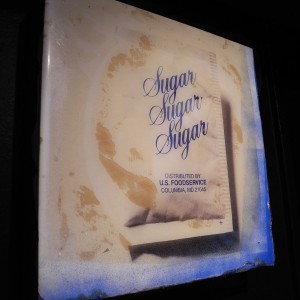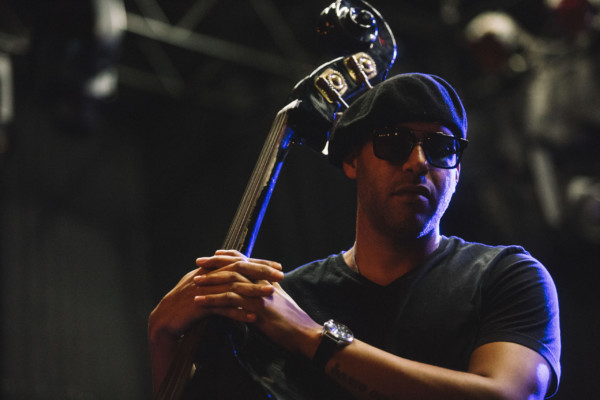Song Exclusive: BFI’s “Sugar”, with Miles Mosley
 If you’ve been reading No Treble for a while, you’ve seen the incredibly talented and forward thinking Miles Mosley rip it up on upright. Mosley brings together elements of jazz, rock, pop, and R&B into his style, which he accents with off the wall techniques and effects.
If you’ve been reading No Treble for a while, you’ve seen the incredibly talented and forward thinking Miles Mosley rip it up on upright. Mosley brings together elements of jazz, rock, pop, and R&B into his style, which he accents with off the wall techniques and effects.
The bassist has a new duo with drummer Tony Austin called BFI. The bass/drum factor usually conjures up thoughts of a rhythm section, but BFI is more than that. Together the artists create a huge pocket with memorable melodies that leave you wondering why we need other instruments in the first place.
Here’s an exclusive preview of their song “Sugar.” Mosley and Austin are making the song available for download by paying with a Tweet.
We also got the chance to catch up with Mosley to get the scoop on the new song, his effects, and his technique.
What’s the story behind “Sugar”?
I started this song with the composition of those bass chords in the verse. I kept looping them over and over once I found them because it felt like such a classic Motown progression, it brought a smile to my face and I couldn’t stop. So after locking down the double stops and the way the voice leading moved around I thought that conceptually it would be great if the words were in subtle opposition to the sound of the piece. There is a piece of art hanging in my writing studio of a package of sugar. It pretty much arrived to me from that point. I’m proud of the lyric, it will probably have a number of different meanings for people, and that’s when I know a lyric is solid, compelling, and in this case a little silly/absurd.
What effects are you using, especially at the :53 and 2:00 marks?
As you can see I’m toggling on and off of a number of combinations for each section.
The Verses are MXR Bass Chorus and Tremolo (:00). The Choruses (:53) have MXR Bass Octave with the Mid boost punched in and the Growl at 12’oclock and a WayHuge Green Rhino. The Solo (2:00) uses the MXR Bass Octave, an MXR Custom Audio MC402 Overdrive, and a Cry Baby 105Q Bass Wah.
How does the use of effects affect your technique?
This is a great question, because one of the biggest mistakes people make is thinking that their technique is separate from the effect. In fact it is very much impacted by what is currently engaged. In the case of “Sugar” there were a couple of things that happened. In the verses I had to be aware of which sweep of the tremolo pedal I was playing the chords on, otherwise the attack of the chord might fall during the lowest volume output.
During the choruses, the distortion pedal, coming after the Octave pedal made it so the slide into the note had this great sustain, and the output of the octave pedal temporarily over-saturated the tone going into the distortion pedal. My technique changes in an instance like that because I want to take a little extra time during that slide to really get the unique character to pop out. Sometimes an effect will have a derivative to it that is unplanned, yet musical enough to be highlighted, in those moments, I will briefly sacrifice technique to make room for the anomaly.
I’d say that I have developed a completely separate technique that “kicks in” when I start using the effects, some of it is sub-conscious at this point but as you experiment you find that there are very subtle, and necessary adjustments that must be made in order to maintain clarity of vision, it still gets away from me sometimes when I get lost in the excitement of it all, but I learn more each day.
Can you tell us about your strumming technique?
There’s an album called Friday Night in San Francisco. It’s an acoustic guitar album with Al DiMeola, John McLaughlin and Paco DeLucia. It is an album that I used for two primary purposes of study. First it was my benchmark for speed. I felt that if I could play at the speed and with the musicality of this record I would have reached a comfortable plateau that married the joy and flexibility of playing fast but still allowed the notes to be heard by the human ear. Second, I spent hours trying to figure out how I could strum like that on bass. Although Sugar doesn’t use the triplet technique I developed the rest is there. It’s a thumb, index, (nail of) middle finger strum. In my opinion, looking to great acoustic guitar players (no pick) will show you what you need to know to develop a technique that suits you personally. It’s a combination of string muting with the left and constant 16th notes in the right hand that will get you started on the right track though.
If I may make a brief departure. I’d like to take a moment and thank NoTreble.com for offering me this moment in time to share this music and these techniques with the bass community. NoTreble is truly a beacon of light amongst the static of the internet where we can all gather and share our voices. It is true that “everything is not for everyone,” but we are all, ultimately, in this together. I am lucky to have companies like Blast Cult, MXR, and Aguilar who share a common belief in what I do, and support my adventures, however the truth is that what glues us all together is bass, and the music we make with these wonderfully crafted instruments and devices. It is through our collected efforts as a community that we may mold and shape a future for our instrument that, through innovation, survives an ever changing sonic palate. I hope that I can answer any questions that you in the community may have in a future Q&A, and that as these videos are released it resonates and rings a desire within some of you to travel down your own paths of innovation. I’d also like to thank Tony Austin. He is not only the Drummer in the video but also engineered, mixed and co-composed the live recording session you are watching.
Download “Sugar” via Pay with a Tweet.




Cool
I love this guy, from way back. He’s the best I’ve ever heard!